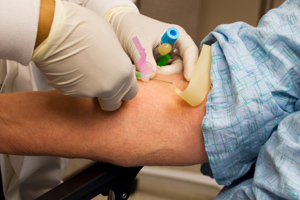LOBBYING is under way to get Medicare funding for HbA1c as a diagnostic test for diabetes because of several problems related to the use of the oral glucose tolerance test.
A new position statement from several of Australia’s leading diabetes clinicians and pathologists supports the use of glycated haemoglobin (HbA1c) as a diagnostic test, particularly as it measures chronic glycaemia and is better tolerated by patients.
The position statement from the Australian Diabetes Society, the Royal College of Pathologists of Australasia (RCPA) and the Australasian Association of Clinical Biochemists (AACB) is published is this week’s MJA. (1)
The statement addresses the importance of early detection of diabetes to significantly reduce the risk of developing complications and to help improve outcomes, saying the introduction of such strategies would have major long-term health and cost benefits for Australia.
It says current tests for measuring blood glucose levels are associated with methodological, procedural and practical problems, particularly the oral glucose test (OGTT) that requires proper pretest preparation, including an appropriate diet for 3 days before the test and a period of fasting.
“The OGTT is also time-consuming, taking at least 2 hours. The glucose load is poorly tolerated by a significant number of people, with nausea, vomiting, delayed gastric emptying and issues of venous access all potentially contributing to an invalid test result.”
Lead author Dr Michael d’Emden told MJA InSight that because of the problems with the OGTT, he suspected that a minority of GPs were already doing HbA1c tests to diagnose diabetes, as were some specialists.
“They are probably doing it in patients with borderline [blood glucose] levels because they don’t like doing OGTTs”, said Dr d’Emden, a clinical associate professor at the University of Queensland and director of the department of endocrinology and diabetes at the Royal Brisbane & Women’s Hospital.
Patients would be at least $25 out of pocket because HbA1c is not covered by Medicare as a diagnostic test. However, Dr d’Emden said an application and cost analysis had been presented to Medicare in January this year to have the test funded for diagnosis. Applications usually take 12‒15 months to be assessed and finalised.
Medicare payment for HbA1c testing is currently only available for people who already have diabetes.
The position statement recommends an HbA1c level of 6.5% (48 mmol/mol) as the cut-off point to diagnose diabetes.
However, it said HbA1c should not be used as a general screening test for diabetes. Initial screening for the disease should be on the basis of the Australian Type 2 Diabetes Risk Assessment Tool score as recommended in the NHMRC guidelines. (2)
“An HbA1c level of < 6.5% (48 mmol/mol) does not negate a diagnosis of diabetes based on elevated glucose parameters. The existing criteria based on fasting and random glucose levels, and on the oral glucose tolerance test, remain valid, and are the diagnostic tests of choice for gestational diabetes, type 1 diabetes and in the presence of conditions that interfere with HbA1c measurement”, the statement said.
Some medical conditions could affect the test and cause falsely high or low readings, particularly conditions affecting red blood cell survival time or non-enzymatic glycation of haemoglobin.
“… any inexplicably high or low HbA1c test result or discrepancy between glucose and HbA1c levels should alert the medical practitioners to a potential problem”, the statement said.
It also highlights the need the HbA1c assay to be reliable and consistent across Australia, pointing out problems in the past with HbA1c test results varying considerably between laboratories.
The statement said although the variability of HbA1c values within Australia was now acceptably low, further improvements in standardisation of HbA1c measurements was expected with the development of a national whole blood external quality control program by the RCPA quality assurance programs and the AACB.
– Kath Ryan
1. MJA 2012; 197: 220-221
2. MJA 2012; 192: 197-202
Posted 20 August 2012

 more_vert
more_vert